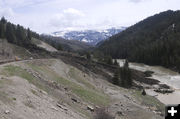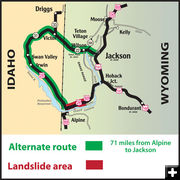

Mudslide
The slide is 40 foot tall and moving at a rate of a foot a minute. Wyoming Department of Transportation photo
|
|
‘There is no practical way to stop the slide’
Once the slide stabilizes, contractors are ready to work 24 hours a day to remove the material on the road
by Wyoming Department of Transportation
May 18, 2011
Because of the volume of mud, rock and water moving across US 26-89 about 24 miles southwest of Jackson, and the speed at which the material is moving, there is no practical way to stop the slide and begin work to reopen the highway until the slide stabilizes naturally.
No retaining structure could hold the slide back because of the amount of water involved, and any attempt to drill horizontally into the moving slide to drain water out would result in broken drainage pipe, WYDOT District Engineer John Eddins said Wednesday.
"The slide is an earth or debris flow, which is soil and rock saturated with water. Containing this type of slide at the rate it is moving would not be safe or practical because it would flow around a structure or berm built for this purpose," WYDOT Chief Engineering Geologist Jim Coffin said. "Capturing the water feeding into the slide would be also be very difficult because the water flows below and above ground and from different sources on the hillside."
The slide is moving at a rate of about one foot per minute with an estimated 40,000 cubic yards of material currently covering the highway to depths of up to 40 feet. WYDOT crews began moving material off the highway Saturday, but by 10 p.m. they could no longer keep the road open. Contractors were brought in to assist Sunday, but by Monday it became clear that effort was only further destabilizing the slide above the road.
"For every loader of dirt we moved out, four more would come down," Eddins said. "No amount of equipment is going to be able to open the road until the slide stops moving."
Eddins estimates about half of the material in the slide is now either on the road or below it.
WYDOT geologists have put stakes and control points on the slide to monitor its movement, and as soon as it stabilizes, work will begin to clear the highway. WYDOT is putting in place a plan to have contractors work 24 hours a day to remove the material on the road once the slide stabilizes. Once work can begin, current estimates indicate it will take five to six days to reopen the road.
Temperatures and precipitation in the area in the coming days could have a significant effect on the length of time it takes for the slide to stabilize.
"Hopefully it will be stabilized soon and we’ll be able to resume the cleanup and get the highway reopened as soon as we can," WYDOT Director John Cox said. "But right now we’re at the mercy of the slide’s movement until it stabilizes itself."
The department has obtained a permit from the U.S. Forest Service to allow it to haul the slide debris to a permanent waste site east of the slide, and is seeking a permit for another site west of the slide. Those waste sites will be reseeded with vegetation, where appropriate, after the cleanup is completed.
WYDOT’s emergency spending policy will allow it to spend up to $1 million on the cleanup with the approval of the Wyoming Transportation Commission.
Gov. Matt Mead’s office has been in conversation with local officials, the Wyoming National Guard and the Wyoming Office of Homeland Security. The governor’s spokesman, Renny MacKay, said the goal is to make sure everyone is aware of the situation and to provide WYDOT and local counties any assistance needed.
"Right now this is not about manpower, it is about geology and engineering," Eddins said. "When this slide stops moving we can implement our plan of attack."
Portable electronic message signs have been placed at highway junctions north and south of the slide to alert travelers to the closure ahead.
Northbound traffic on US 26-89 can continue on US 26 into Idaho north of Alpine Junction. That route passes through Irwin and Swan Valley before becoming Idaho Highway 31, which turns to the east through Victor and into Wyoming, where WYO 22 crosses Teton Pass into Jackson. Southbound traffic can reverse that route to detour around the slide. The alternate route adds about 36 miles to the length of the trip.
Vehicles weighing more than 80,000 pounds and all trailers, including boats and campers, will be prohibited on Teton Pass from 6 a.m. to 9 a.m. and from 3 p.m. to 6 p.m. to facilitate daily commuters during the closure.
A time-lapse video of the slide movement Tuesday can be viewed on WYDOT’s Facebook Fan Page at www.facebook.com/pages/WYOMING-DEPT-OF-TRANSPORTATION/288387851340
|

